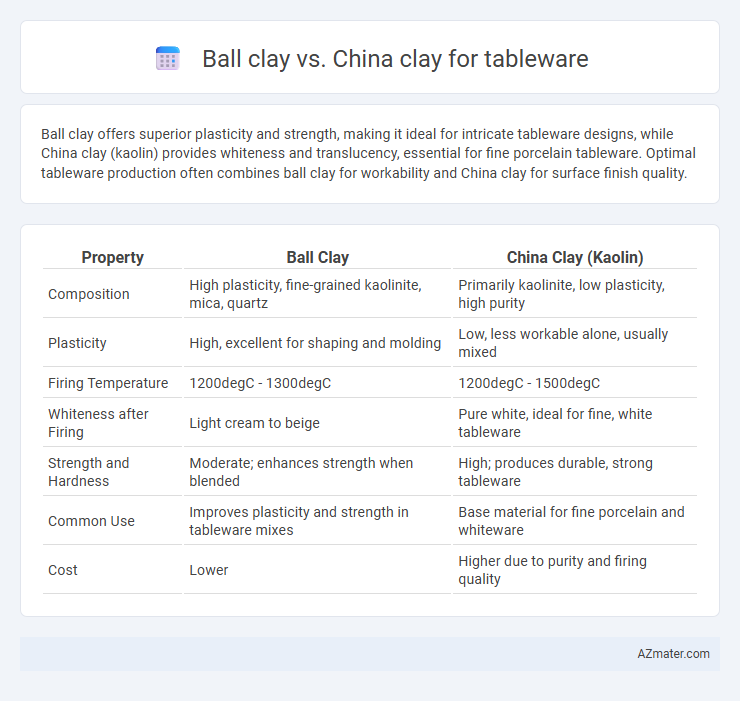Ball clay offers superior plasticity and strength, making it ideal for intricate tableware designs, while China clay (kaolin) provides whiteness and translucency, essential for fine porcelain tableware. Optimal tableware production often combines ball clay for workability and China clay for surface finish quality.
Table of Comparison
| Property | Ball Clay | China Clay (Kaolin) |
|---|---|---|
| Composition | High plasticity, fine-grained kaolinite, mica, quartz | Primarily kaolinite, low plasticity, high purity |
| Plasticity | High, excellent for shaping and molding | Low, less workable alone, usually mixed |
| Firing Temperature | 1200degC - 1300degC | 1200degC - 1500degC |
| Whiteness after Firing | Light cream to beige | Pure white, ideal for fine, white tableware |
| Strength and Hardness | Moderate; enhances strength when blended | High; produces durable, strong tableware |
| Common Use | Improves plasticity and strength in tableware mixes | Base material for fine porcelain and whiteware |
| Cost | Lower | Higher due to purity and firing quality |
Introduction to Ball Clay and China Clay
Ball clay is a fine-grained, highly plastic sedimentary clay composed mainly of kaolinite, used in tableware production for its excellent binding properties and high plasticity. China clay, also known as kaolin, is a pure form of kaolinite with low impurity levels, valued for its whiteness and refractory characteristics, making it essential for producing durable and aesthetically pleasing tableware. Both clays contribute to the quality of ceramic products, with ball clay enhancing workability and china clay improving whiteness and strength.
Composition Differences: Ball Clay vs China Clay
Ball clay contains a higher percentage of kaolinite, mica, and quartz, giving it excellent plasticity and strength, which is ideal for shaping intricate tableware. China clay, primarily composed of kaolinite with minimal impurities, offers a purer, whiter appearance suitable for fine porcelain and high-quality tableware finishes. The compositional distinction affects the molding properties, translucency, and durability of tableware items made from each clay type.
Geological Origins and Extraction
Ball clay originates from sedimentary deposits rich in kaolinite, mica, and quartz, formed through the weathering of feldspathic rocks in freshwater environments. China clay, or kaolin, is primarily derived from the chemical weathering of granite or granitic rocks, resulting in a pure kaolinite mineral composition. Extraction of ball clay typically involves open-pit mining in river valleys, whereas china clay is extracted through surface mining and processing of kaolin-rich soils or residual deposits.
Physical Properties Comparison
Ball clay exhibits higher plasticity and finer particle size compared to China clay, enhancing its workability and strength in tableware production. China clay, or kaolin, provides superior whiteness and thermal stability, important for achieving smooth finishes and durability in fired ceramics. The denser structure of ball clay increases drying shrinkage, whereas China clay's lower plasticity reduces warping risk during manufacturing.
Plasticity and Workability in Tableware Production
Ball clay offers higher plasticity than China clay, enhancing workability during tableware production by allowing more flexible shaping and forming processes. The fine particle size and smooth texture of ball clay contribute to improved moldability and surface finish in ceramics. China clay, while less plastic, provides greater whiteness and purity, often used as a flux to balance plasticity and strength in tableware compositions.
Firing Temperatures and Thermal Behavior
Ball clay typically fires at lower temperatures between 1100degC and 1200degC, exhibiting excellent plasticity and smooth texture, making it ideal for producing fine tableware with intricate detailing. China clay (kaolin) requires higher firing temperatures, around 1200degC to 1400degC, resulting in stronger, more vitrified tableware with enhanced thermal and mechanical stability. The differences in thermal behavior influence durability and resistance to thermal shock, with china clay offering superior performance in high-temperature and everyday use scenarios.
Impact on Final Tableware Quality
Ball clay enhances tableware by providing excellent plasticity and workability, resulting in smoother, more refined shapes and higher mechanical strength after firing. China clay (kaolin) contributes to whiteness, translucency, and thermal resistance, improving the aesthetic appeal and durability of finished products. The optimal balance of ball clay and china clay in the clay body directly impacts the tableware's final quality, combining strength, appearance, and functional performance.
Common Applications in the Tableware Industry
Ball clay and China clay serve distinct roles in the tableware industry, with ball clay prized for its plasticity and strength, making it ideal for shaping intricate designs and enhancing durability in ceramic bodies. China clay, also known as kaolin, is primarily used for its whiteness and purity, contributing to the smooth surface and high firing temperature resilience essential for fine porcelain and high-quality tableware. Both clays are integral in producing functional and aesthetically pleasing dishes, cups, and decorative ceramic pieces.
Environmental and Economic Considerations
Ball clay offers higher plasticity and strength, reducing breakage rates in tableware production, which lowers waste and energy consumption, making it economically advantageous. China clay (kaolin) has lower plasticity but is abundant and less costly, with a lower environmental footprint due to less intensive mining processes. Selecting ball clay can increase durability and reduce production loss, while China clay supports sustainable sourcing and cost efficiency in large-scale tableware manufacturing.
Choosing the Right Clay for Tableware Manufacturing
Ball clay offers high plasticity and strong binding properties, making it ideal for intricate tableware designs that require durability and fine detail. China clay, or kaolin, provides whiteness and translucency, essential for achieving a smooth, refined finish favored in premium tableware. Selecting the right clay depends on balancing plasticity, strength, and aesthetic qualities to ensure both functionality and visual appeal in the final product.

Infographic: Ball clay vs China clay for Tableware
 azmater.com
azmater.com